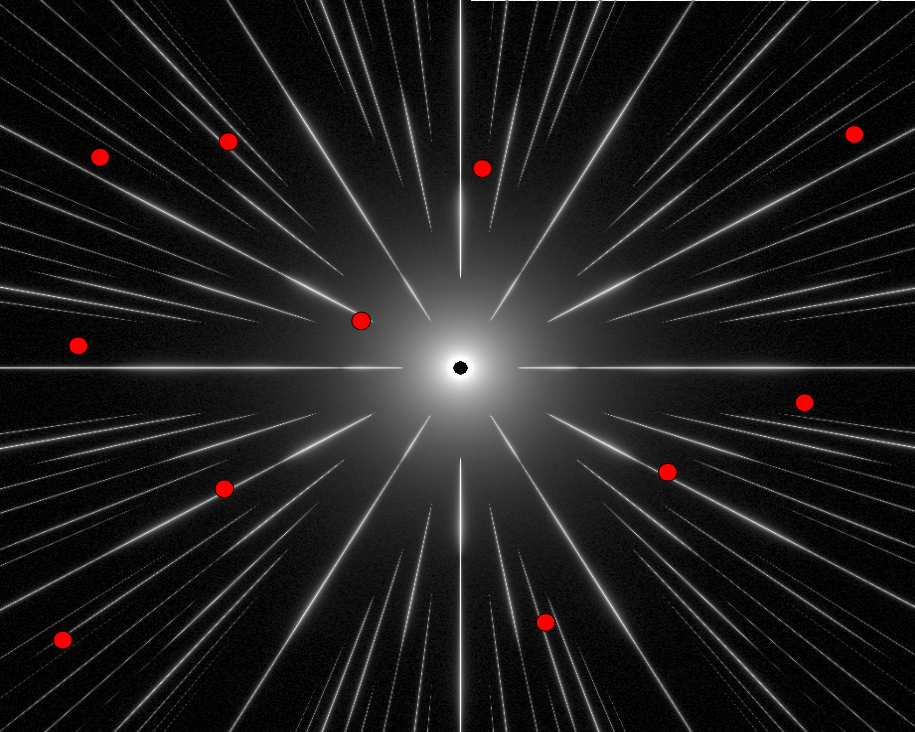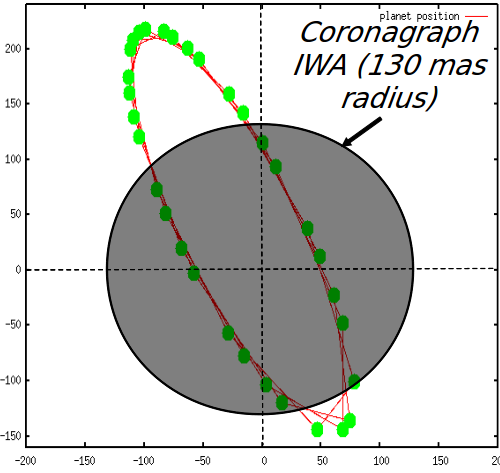|
Show content only (no menu, header)
A Concept for high precision Astrometry with a Space Coronagraph
What is this about ?
"Astrometry is the branch of astronomy that involves precise measurements of the positions and movements of stars and other celestial bodies. The information obtained by astrometric measurements provides information on the kinematics and physical origin of our Solar System and our Galaxy, the Milky Way." (Source: Wikipedia)
"A coronagraph is a telescopic attachment designed to block out the direct light from a star so that nearby objects - which otherwise would be hidden in the star's bright glare - can be resolved. Most coronagraphs are intended to view the corona of the Sun, but a new class of conceptually similar instruments (called stellar coronagraphs to distinguish them from solar coronagraphs) are being used to find extrasolar planets around nearby stars." (Source: Wikipedia)
Both techniques are very useful to astronomy to identify and study exoplanets (planets around other stars): with a coronagraph, we can directly image planets and study them through spectroscopy (color information); with astrometry, we can measure the planet's gravitational pull on the star and therefore measure the planet's mass.
This webpage describes how both techniques could be realized on a a single space telescope. One of the main challenge is that the planet's pull on the star (astrometric signal) is very small and the position of the star on the sky therefore needs to be measured to very high precision.
Contributors
Michael Shao (NASA JPL) Improvements to original concept, error budget, exoplanet science
Stuart Shaklan (NASA JPL) Error budget, mission architecture
Robert Woodruff (LMC) Optical design for wide field telescope compatible with coronagraphy
Bijan Nemati (NASA JPL) Numerical simulations, modeling approach
Mark Ammons (UofA) Lab demo design & operation
Eduardo Bendek (UofA) Lab demo optical design & operation
Tom Milster (UofA) Mask manufacturing, scaling of mask manufacturing to full scale PM
Jim Burge (UofA) Mask manufacturing, scaling of mask manufacturing to full scale PM
Neville Woolf (UofA) Exoplanet science, concept definition
Roger Angel (UofA) Exoplanet science, concept definition
Josh Eisner (UofA) Exoplanet and star formation/evolution science
Marie Levine (NASA JPL) System engineering, mission architecture
Joe Pitman (Expl. Sci.) System engineering
Ruslan Belikov (NASA Ames) Compatibility with coronagraphy
Daniel Eisenstein (UofA) Extragalactic science enabled with wide field camera
Ann Zabludoff (UofA) Extragalactic science with wide field camera
Dennis Zaritsky (UofA) Extragalactic & galactic science with wide field camera
Jay Daniel (L3/Tinsley) Optics manufacturing
 |
Ongoing work - this webpage is likely to be updated frequently in the near future. We are looking for help / comments on this, so if you want to participate, please email me (and please let me know if your email can be included in this webpage in the discussion section).
Since many key issues and technical choices remain to be explored the performance estimates given in this document are only indicative. Please read the Outstanding issues, future work paragraph at the end of this page for more information.
|
Background
Detection and characterization of potentially habitable Earth-mass exoplanets is one of the leading astronomical challenges of our age. Two approaches -- direct planet imaging and host star astrometry -- have the potential for revolutionary discoveries:
- Direct imaging of exoplanets with future space telescopes will reveal their atmospheric composition and possibly identify signs of biological activity.
- The precise measurement of the host star position on the sky using astrometry will yield the planet mass.
While either technique is suitable to identify new planets, both are required for unambiguous characterization of potentially habitable worlds. It has been so far assumed that coronagraphic imaging/spectroscopic measurement and mass determination require two separate missions, therefore requiring prioritization between the two paths and most likely leading to several years of time interval between the two measurements. An approach is proposed here that combines the two critical techniques using a single space telescope in which light is simultaneously fed to a narrow field coronagraph for direct imaging and spectroscopy and a wide field astrometric imaging camera imaging a wide annulus around the central field for mass measurement with astrometry. The technique is discussed here for a medium-sized (1 to 2-m) space telescope, but could be applied on larger or smaller telescopes.
References of interest on this topic include:
- "The Synergy of Direct Imaging and Astrometry for Orbit Determination of exo-Earths" Shao, Michael; Catanzarite, Joseph; Pan, Xiaopei, ApJ, in press (2010) [astro-ph link]
Principle
 |
Astrometric detection of Earth-mass planets requires sub-micro-arcsecond accuracy, which is theoretically possible with a medium-size telescope imaging background stars around the bright host star. In the photon noise limit, the combined brightness of background stars in a 0.25 square degree field is sufficient to provide 1/20 of a micro-arcsecond astrometric accuracy in a 2-day observation with a 1.4-m diameter visible space telescope. The measurement is however technically challenging, and must overcome distortions which are several orders of magnitude above the photon noise limit. To address this issue, the astrometric motion of the host star is measured by comparing motion of its internally generated diffraction spikes to the background stars. The diffraction spikes are generated using a 2-D grid of regularly spaced small dark spots added to the surface of the primary mirror that do not contribute to scattered light in the central coronagraph field. Because the diffraction spikes are created on the primary mirror and imaged on the same focal plane detector as the background stars, astrometric distortions due to optics or focal plane array geometry affect equally the diffraction spikes and the background stars, and can therefore be calibrated.
|
For a more detailed explanation of the technique, see: Principle
Precursors :
Putting a regular mask as the first element of an imaging telescope to create astrometric references by diffraction was done in the 1930s for astrometry of binary stars (especially when the contrast between the 2 stars is challenging for photographic plates). See this figure for a nice example.
More recently, regular grid masks have been inserted in coronagraph instruments to perform astrometry. See this figure for a quick description. While the technique is optically similar to the one we propose, the goals for this technique are somewhat different (astrometry of the planet orbit instead of the star wobble), and putting the grid mask inside the instrument does not address the wide field distortion problems which our concept is aimed at calibrating.
Data Acquisition and Processing
 |
Images of the spikes and the background stars are acquired simultaneously by the focal plane array, while the telescope is slowly rolling. This allows calibration and averaging of astrometric errors down to sub-micro-arcsecond precision.
Large scale distortions
The images of the diffraction spikes acquired on the same target at different observation epochs are compared to measure how large scale astrometric distortions change between epochs. These distortions are removed from the measurement of the background star motion between epochs.
Small scale distortions
The diffraction spikes in the focal plane are spaced by 10 to 20 arcsecond and contain a finite number of photon: they can therefore only measure large scale distortions to the required accuracy. Small scale distortions (typically smaller than the 10 to 20 arcsecond between spikes) exist, and are due to high spatial frequency aberration on optics and detector imperfection such as unknown pixel geometry and response between and within pixels. The small scale astrometric distortions are averaged down to sub-micro-arcsecond thanks to both a slow roll of the telescope during the observation and the large number of background stars used as the astrometric reference.
|
For a more detailed description of data acquisition and processing, see: Data Acquisition and Processing
Science, Performance
 |
An example error budget is shown and discussed to identify major sources of error for a 1.4-m telescope imaging a 0.1 squaredeg field of view at the galactic pole. Preliminary analysis indicate that sub-micro-arcsecond single measurement (2-day observation) accuracy is feasible. Ultimately, the actual precision will therefore be driven by wavefront and detector stability over long periods of time, and based on controlling a slew of instrumental errors. With astrometric observations at 36 epochs of two days each, a 1.4-m telescope could survey 20 stars within 6 parsec for Earth mass planets in four years of integration time. Simultaneous coronagraphic imaging and astrometric measurements will enhance both observation techniques by reducing confusion between multiple planets. Planets embedded in exozodiacal clouds will be more easily extracted from coronagraphic images. Moreover, the astrometric and coronagraphic techniques share many of the same requirements for stability and precision, so that combining them on a single mission offers significant savings. The deep diffraction-limited optical images acquired by the wide field camera will also provide supplemental general astrophysics investigations. The resulting mission would be a powerful and cost-effective approach to identify and characterize exoplanets. The combined astrometry measurement and coronagraphic imaging data will yield unprecedented characterization of potentially habitable planets, by simultaneously providing planet orbit, planet mass, a low resolution reflectance spectrum of the planet surface/atmosphere with time domain information, a measurement of the exozodiacal cloud and other more massive planets in the system
|
This scheme can be used on any internal coronagraph mission (but cannot be used on the external occulter) with little modification of the telescope or spacecraft except for the addition of a wide field camera and introduction of a series of small black spots on the primary mirror. The stability requirements imposed on the telescope and spacecraft by the coronagraph create a stable PSF well suited for this technique.
More information is provided in the description of Science goals and performance and a detailed estimate of performance is provided in Error budget, Simulations .
Note: A step-by-step description of the numerical model and its results is given in this set of 60 slides
Laboratory validation
We are currently setting up a laboratory testbed at the University of Arizona. For more details, visit this page.
- The effect of changes in the PSF shape between observations has not been simulated
- spots may move laterally on PM (as pointed out by Mike Ireland and Mike Shao), requiring at some
level stability on PM over long timescales - this will need to be
quantified.
- coatings on optics and spots may degrade over the mission lifetime,
which could affect calibration with spikes. This may prevent comparing
spike images separated by long periods of time.
- astrometric distortions which change within a single observation have
not been modeled
- current model of how pixels age with time due to radiation env. is
simplistic and this needs more work and analysis
- it is still unknown how well we can use data (spike image) from one
star to calibrate another one. If we can do that, then we can track
during the mission the slow calibration drift over a long period of
time.
- astrophysical noise sources have not been included. This includes star
spots but also companions around some of the background stars used as a
reference
Publications
- "Single aperture imaging astrometry with a diffracting pupil: application to exoplanet mass measurement with a small coronagraphic space telescope" [ppt] SPIE meeting, June 2010, San Diego, 7731-83
Page content last updated:
27/06/2023 06:35:52 HST
html file generated 27/06/2023 06:34:39 HST
|

